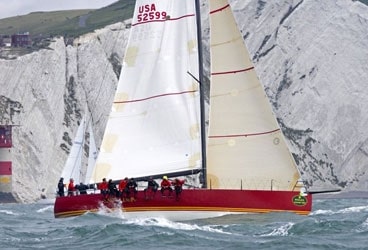
SnowLion368
We finished the 2007 Fastnet Race on Snow Lion on a Thursday morning about 6 a.m., less than three days elapsed time since the delayed start on Monday. This was by far the fastest of the three Fastnets I have done, evidenced by Leopard’s breaking the record by almost 9 hours. (Kudos to Ken Read and the crew of Rambler for beating them around the Rock). What was remarkable to us when we got into Plymouth was to find out that over 200 of the 271 starters dropped out of the race! (This doesn’t count the 29 registered boats that never even started.) The worst night was the first with lumpy seas and 30 to 35 knots on the nose–with occasional driving rain. Still, it was mild compared to last year’s Vineyard race.Personally, I think three factors contributed to the high number of retirees. One was psychological: the 25-hour delayed start plus the dock talk about the potential weather cast a feeling of doom and gloom over the fleet, especially after a week of light air and sunshine during Cowes Week. Of the crews of retired boats that I spoke to in Plymouth, some indeed experienced actual equipment issues, but others were simply concerned about entering the Irish Sea given the weather they were experiencing in the Channel. I think many of the crews knew in the back of their heads that they would likely retire before reaching Land’s End; it was just a question of when and where along the coast they would do so. Good on the race committee for delaying the race to give the participants the option to do so. I will never question a skipper’s decision to retire. In fact, one could argue that so many dropouts reflect good sound judgment, especially since more than half of the 300 registered boats were under 40 feet and the prospect of a long, windy beat across the Irish Sea to Fastnet Rock can wither one’s will pretty quickly. Which brings me to the second reason for the high number of drop outs: as long as there are a lot of small boats (e.g. 30 to 35 feet) in the race, you’ll have a high number of retirees. The last factor was obviously the weather forecast itself. In the days leading up to the start, it kept changing with great frequency (every six hours or so), plus the U.S. and British GRIB files were sometimes agreeing, sometimes not. At times it looked pretty grim. Nevertheless, by the time we started on Monday the forecasts were pretty solid and not too nasty, but by no means benign, especially for the little guys. Indeed, the last forecast played out very accurately during the race. But some of the earlier uncertainty no doubt lingered with some of the crews, and contributed significantly to the psychological factor mentioned above.Now to the race. What a great ride! The start off the Royal Yacht Squadron is always spectacular. First go the Open 60s. Then the smallest to the largest. Great upwind tacking duels and boat dodging out the Solent in 20 knots in bright blue skies. By the time we reached the Needles, 270 boats were crisscrossing in short, steep seas. To see Alfa Romeo on one side and some 35-foot cruiser on the other is a marked contrast to say the least– but each command the same respect when they’re on starboard.After we cleared the Needles we sailed upwind to Portland Bill and then on to the Lizard and Land’s End, just laying on port tack. This first night was the worst – basically beating into a 30-knot breeze in very confused and quite large seas. At points it was raining so hard it hurt to look forward. This first night is when most of the retirees decided to call it quits, taking shelter in multiple ports along the coast. (Go to the tracker on the Fastnet website to see all the boats scurrying for port.) We fared well with a double reef and the number four. The conditions slowly moderated the next morning. We reached Land’s End about 9 a.m. Tuesday and experienced “glue pot” dead air conditions near the cliffs for about 40 minutes. Then we were off into the Irish Sea, sailing just off the wind but basically close-hauled in an ever-freshening breeze. When we got close to Fastnet Rock the breeze went ahead and moderated momentarily. We rounded the rock at about 5 a.m. Wednesday. It was time for some downwind sailing back across the Irish Sea to the Scillies. We had a lot of fun in surfing conditions all during the leg. I had the record of 22.3 knots with some great coaching from my watch captain, Jay Hansen. (Later my record was broken by the other watch who briefly hit 24 knots.) We rounded the huge lighthouse off the Scillies at sunset Wednesday night. Those are some rocks! We could only imagine a 17th century British frigate coming home from battle only to break up on those rocks in a storm. After rounding we sailed with the A5, A3, and then jib top, finishing at daybreak Thursday with the code zero. At the dock in Plymouth to greet us were the crew of Chieftain, the Irish Cookson 50 and overall winner of the race. They brought trays and trays of beer to the boat while we cleaned up and the war stories commenced.We felt we had sailed a very good race both tactically and from a crew work perspective. The boat and sails held up very well. The Snow Lion program is exceptional from top to bottom, starting with the owner/skipper/navigator/helmsman/grinder Larry Huntington– yes he does do it all, and does it all very well! We ended up first in our division and 13th overall, sailing a very similar track as Chieftan. We all had fun, challenged ourselves, and learned a lot. Cheers!









